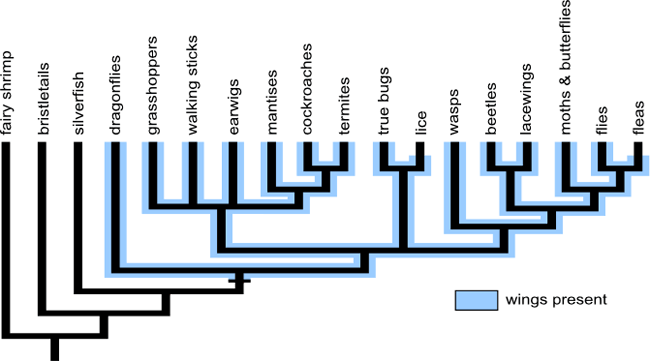Keep it simple. Include only the taxa necessary to tell the full story — extraneous branches only distract from the message. (However, note than in a few cases, including extra taxa can help visitors avoid certain misinterpretations; for details, see our Tree Design Tips). Sometimes higher taxonomic levels such as genus, family, or order will be preferable to the species level. For example, in the original scientific paper, the insect tree below had 35 different tips. This would have been overwhelming. So we decided to leave off many of the less familiar groups (e.g., dobsonflies). However, we wanted to show that wings were gained and then lost in some cases, so we made sure to include dragonflies and fleas. We didn’t want the tree to look too much like it was “leading up to” the insects at the right side of the tree, so we included groups that would make the tree look “bushier.” This sort of decision-making is a normal part of the process.

- Should I include an outgroup — a lineage that is closely related to the group of interest but not a member of that group? It depends. Outgroups can be helpful for showing how characters evolve in a group of interest. They can also be helpful if the outgroup is unexpected, interesting, or related to your learning goals. For example, in the tree below, the outgroup to whales (hippos) was included because it is an interesting and new finding. However, if you are really focusing on just one group, you may not need to include an outgroup at all.
- Should I show how my group is related to other groups or to the entire tree of life? If you are showing the relationships among a particular group (e.g., horses), keep in mind that this can be consistent with an essentialist/creationist view of evolution within groups. To reinforce the idea that all life is related, consider including one or two non-group members or, in a separate diagram near your main image, showing how your group is nested within a more encompassing tree.

This tree from the Field Museum shows how plants are nested within the more encompassing tree of life. See a larger version of this tree. Graphic courtesy of the Field Museum. - Should I include humans on my tree (as an outgroup or otherwise)? There are many reasons to consider this option: to show that humans are related to all other life, to show that humans are animals, to make the tree personally relevant and pique interest in less familiar organisms, and to combat misunderstandings about progressive evolution and the idea that different groups are ranked on an evolutionary ladder (e.g., that humans are on the top of the evolutionary ladder). However, if these topics are not related to your learning goals or if humans are very distantly related to the organisms that are the focus of the exhibit, the inclusion of humans may feel out of place or be misleading.
Sometimes there are taxa that you need to include on your tree, but the relationships among them haven’t been firmly established. Read on to find out how to handle this …
